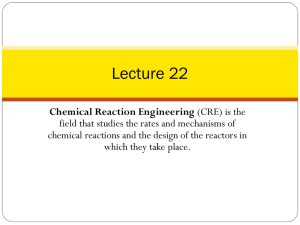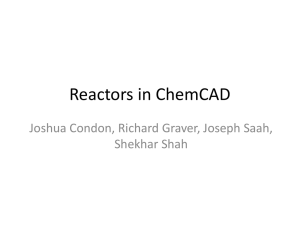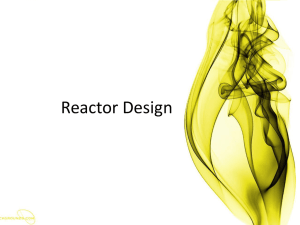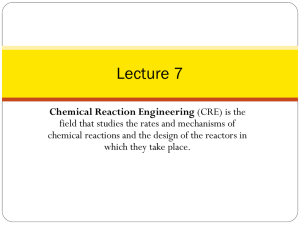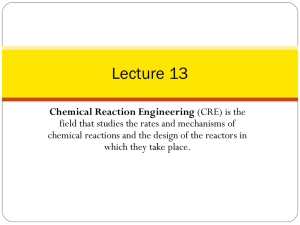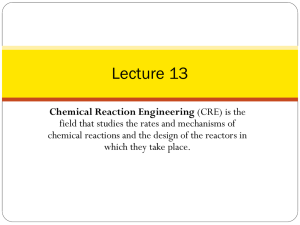Thermodynamic Property Methods
advertisement
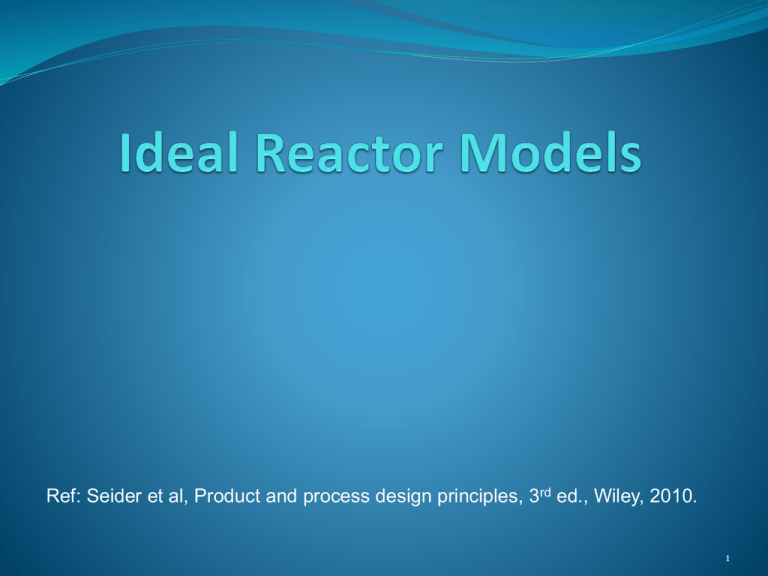
Ref: Seider et al, Product and process design principles, 3rd ed., Wiley, 2010. 1 Reactor Models Chemical reactors, particularly for continuous processes, are contains: multiple phases, different geometries, and various regimes of momentum, heat, and mass transfer. There are so many configurations, involving different combinations of these attributes, that attempts to develop generalized reactor models have met with limited success. Most of the process simulators provide four kinds of reactor models. These ideal models are used in the early stages of process synthesis, when the details of the reactor designs are less important, but reactor effluents and heat duties are needed. 2 Reactor Models The common ideal reactor models are: Stoichiometric or conversion model that permits the specification of reactant conversions or extents of reaction for one or more specified reactions. 2. Two models for multiple phases (vapor, liquid, and solid) in chemical equilibrium, one for known reactions and the other one for unknown reactions (Gibbs model). 3. A kinetic model for a continuous-stirred-tank reactor (CSTR) that assumes perfect mixing of homogeneous phases (liquid or vapor). 4. A kinetic model for a plug-flow tubular reactor (PFR), for homogeneous phases (liquid or vapor) and assuming no backmixing (dispersion). 1. 3 Reaction Stoichiometry For most of the reactor models in the flowsheet simulators, it is necessary to provide R chemical reactions involving C chemical species: C ij A j 0 , i 1 , , R j 1 where Aj is the chemical formula for species j and νij is the stoichiometric coefficient for species j in reaction i (negative for reactants, positive for products). As an example, for the manufacture of methanol, the reaction can be written as -2H2 - CO +CH3OH = 0, and the stoichiometric coefficient matrix is: ij 2 H 2 1 CO 1 CH 3 OH 4 Extent of Reaction Consider a single reaction. In the stoichiometric reactor models, one can specify the fractional conversion, Xk , of key reactant k : Xk n k , in n k , out , n k , in 0 Xk 1 or the extent (number of moles extent) of reaction: n j , out n j , in , j 1 , , C j Based on the above equations, the molar flow rates of the components in the reactor effluent can be calculated by: n j , out n j , in j n k , in X k k , j 1 , , C OR n j , out n j , in j , j 1 , , C 5 Extent of Reaction For multiple reactions, the reactions must be specified as series or parallel. The series reactions are equivalent to having reactors in series with the feed to each reactor, except the first, being the product from the previous reactor. Each reaction can have a different key reactant. For parallel reactions, it is preferable to specify the extent of reaction for each reaction, which results in: R n j , out n j , in i ij , j 1 , , C i 1 6 Chemical Equilibrium A chemical reaction can be written as a general stoichiometric equation, in terms of reactants A, B, etc., and products R, S, etc., aA bB rR sS A reaction is characterized by two important thermodynamic quantities, namely the heat of reaction and the Gibbs (free) energy of reaction. Furthermore, these two quantities are functions of temperature and pressure. For many reactions, the effect of temperature on the heat of reaction is relatively small. By contrast, the effect of temperature on the Gibbs energy of reaction can be very large. 7 Chemical Equilibrium For example, the reaction of CO and H2 to form gaseous methanol, CO 2H 2 CH 3 OH o has an standard heat of reaction, H rxn , at 25°C of -90,400 kJ/kmol of methanol, while at 800°C, the heat of reaction, is -103,800 kJ/kmol, a relatively small change for such a large change in temperature. For the same methanol formation reaction, the standard Gibbs o energy of reaction, G rxn , is -25,200 kJ/kmol at 25°C. Already, at 500°C, the Gibbs energy of reaction, has undergone a drastic change to +88,000 kJ/kmol. 8 Chemical Equilibrium For a specified feed composition and final temperature and pressure, the product composition at chemical equilibrium can be computed by either of two methods: 1. Chemical equilibrium constants (K-values) computed from the Gibbs energy of reaction combined with material balance equations for a set of independent reactions. This method is applicable when the stoichiometry can be specified for all reactions being considered. 2. The minimization of the Gibbs energy of the reacting system. This method requires only a list of the possible products. 9 Chemical Equilibrium For the first method, a chemical equilibrium constant, K, is computed for each independent stoichiometric reaction in the set, using the equation, r s o G rxn K a b exp RT a AaB aRaS where ai, is the component activity. For a gas solution, the activity is given by a i i y i P i Pi , where i , is the fugacity coefficient of component i in the gas mixture. It is common to replace the activity in the equation for K with the above equation to give: r s r s yR yS R S K a b a b y A y B A B where K 1 .0 r s r s r s a b yR yS P P r s a b R S P a b K P a b K yA yB P A PB for low to moderate pressures. 10 Chemical Equilibrium For a liquid solution, the activity is given by V s a i x i i exp i ( P Pi ) RT where γi is the activity coefficient of component i in the liquid mixture and is equal to 1.0 for an ideal liquid solution, V i is the partial molar volume of s component i, and Pi is the vapor pressure of component i. It is common to replace the activity in the equation for K to give: r s r s r s xR xS R S xR xS K a b K a b a b x A x B A B xA xB where K 1 .0 for ideal liquid solutions at low to moderate pressures. 11 Chemical Equilibrium Example 1: Steam-Methane Reforming Example 1: Calculate the effluent component mole flow rates of a steammethane reforming reactor at 1050 K and 5 bar, if the feed contains 125 kmol H2O/hr and 50 kmol CH4/hr. Solution: The main two equilibrium reactions of the SMR are: H 2 O CO 3H Reaction (1) : CH Reaction (2) : CO H 2 O CO 4 2 H2 2 , K 1 ( at 1050 K) 94 . 2 atm , K 2 ( at 1050 K) 1.2 2 At equilibrium, one can write (with ideal gas assumption): 3 K1 y CO y H 2 y CH 4 y H 2 O P 2 , K2 y CO 2 y H 2 y CO y H 2 O The mole fraction of each component in the product (at equilibrium condition) can be related to the extent of reactions (ξi), as follows: n H 2 O , out 125 1 2 , n CH 4 , out 50 1 , n CO , out 1 2 n CO 2 , out 2 , n H 2 , out 3 1 2 , n total , out 175 2 1 12 Chemical Equilibrium Example 1: Steam-Methane Reforming After substitution the above equations in the Ki equations, the following set of nonlinear equations will result: 25 ( 1 2 ) ( 3 1 2 ) 3 94 . 2 ( 50 1 )( 125 1 2 ) (175 2 1 ) 2 0 ( 2 ) ( 3 1 2 ) 1 . 2 ( 1 2 ) (125 1 2 ) 0 By solving the above set of equations (for example ), the extant of each reaction and component mole flow rates are resulted as: 1 44 . 42 2 15 . 33 n H O , out 65 . 25 2 n CH 4 , out 5 . 58 n CO , out 29 . 09 n 15 . 33 CO 2 , out n H 2 , out 148 . 60 kmol/hr " " " " 13 Kinetics Power Law For homogeneous non-catalytic reactions, power-law expressions are commonly used for regression of laboratory kinetic data. The general power-law kinetic equation for key component (the component that has the stoichiometric coefficient of +1) is: rk k 0 T n E C exp C i i , r j v j rk RT i 1 where rj is the rate of production of component j (unit in Aspen Plus: kmol/m3-s or kmol/kg cat-s), Ci is the concentration of component i (unit in Aspen plus: molarity, kmol/m3; mole fraction; mass fraction; partial pressure, Pa; mass concentration, kg/m3), k0 is the pre-exponential factor, αi, is the order of reaction with respect to component i, E is the activation energy, C is the number of components, and T is the reaction temperature (unit in Aspen plus: Kelvin). 14 Kinetics LHHW For reactions that are catalyzed by solid porous catalyst particles, the sequence of elementary steps may include adsorption on the catalyst surface of one or more reactants and/or desorption of one or more products. In that case, a Langmuir-Hinshelwood-HougenWatson (LHHW) kinetic equation is often found to fit the experimental kinetic data more accurately than the powerlaw expression. The LHHW rate expression for key component can be written as: rk (kinetic factor)(dr iving force expression (adsorptio n expression ) ) , r j v j rk 15 Kinetics LHHW where, Kinetic Driving factor k 0 T n E exp RT force expression C k 1 C i i i 1 K l C l 1 j 1 M Adsorption expression C C k 2 C j j j 1 l, j j m k1, k2 and Kls are constant or a function of temperature. The definition of other parameters are the same as power-law expression. 16 Ideal Kinetic Reaction Models CSTR The simplest kinetic reactor model is the CSTR, in which the contents are assumed to be perfectly mixed. Thus, the composition and the temperature are assumed to be uniform throughout the reactor volume and equal to the composition and temperature of the reactor effluent. A perfectly mixed reactor is used often for homogeneous liquid-phase reactions. In the CSTR model, the reaction may be takes place under adiabatic or isothermal conditions. Although calculations only involve algebraic equations, they may be nonlinear. Accordingly, a possible complication that must be considered is the existence of multiple solutions, two or more of which may be stable. 17 Ideal Kinetic Reaction Models CSTR Consider the case of non-adiabatic operation with R chemical reactions. the mole and energy balance, can be written as: w C in j , in w C out j , out R v i , j rk i V r 0 i 1 , j 1, , C w ( H in H out ) Q 0 where, w is the mass flow rate, ρ is the mixture density, Cj is the molarity of component j, vi,j is the stoichiometric coefficient of component j in reaction i, rk is the rate of production of key component, Vr is the volume of reacting mixture, H is the mixture enthalpy (energy/mass), and Q is the heat duty (energy/time) added to the reactor. In process simulators, the standard enthalpy of formation of each component are considered in calculating of mixture enthalpy. Therefore, the heat of reaction is handled automatically. 18 Ideal Kinetic Reaction Models Example 2: Hydrolysis of Propylene Oxide Example 2: Propylene glycol (PG, normal boiling point is 460.7 K) is produced from propylene oxide (PO) by liquid-phase hydrolysis with excess water under adiabatic and near-ambient conditions, in the presence of a small amount of soluble sulfuric acid as a homogeneous catalyst: C 3H 6O H 2O C 3H 8O 2 Because the exothermic heat of reaction is appreciable, excess water is used. Furthermore, because PO is not completely soluble in water, methanol is added to the feed, which enters the reactor at 23.9 oC, 3 bar, and with the following flow rates (kmol/hr): PO = 18.712, Water = 160 to 500, Methanol = 32.73 It is proposed to consider the use of an existing agitated reactor vessel, which can be operated adiabatically at 3 bar, with a liquid volume of 1.1356 m3. The powerlaw kinetic equation of the reaction is: rPO 9 . 15 10 where 22 1 . 556 10 5 exp RT rPO kmol/(m 3 2 kJ C PO , R 8 . 314 kmol - K - s) , C PO kmol/m 3 , and T K 19 Ideal Kinetic Reaction Models Example 2: Hydrolysis of Propylene Oxide Carry out a sensitivity analysis to investigate the effect of the water feed rate on the operating temperature and the PO conversion. Solution: The reactor was simulated by Aspen Plus. The WILSON method and RCSTR are used in the simulation. After converging the simulation, a SENSITIVITY ANALYSIS was added to the simulation with water flow rate as manipulated (independent) variable and temperature and PO conversion as defined (dependent) variables. The Sensitivity was run in two cases, one with varying the water flow rate in the range of 160 to 500 kmol/hr with step size of 1.0, and the other with varying the water flow rate in the range of 500 to 160 with step size of -1.0. The resulted temperature and PO conversion in two cases as a function of water flow rate are shown in the following FIGURES. 20 Ideal Kinetic Reaction Models 390 1 380 0.9 370 0.8 PO Conversion Reactor Temperature (K) Example 2: Hydrolysis of Propylene Oxide 360 350 340 330 320 0.7 0.6 0.5 0.4 0.3 0.2 310 0.1 300 0 290 160 210 260 310 360 410 Water flow rate (kmol/hr) 460 160 210 260 310 360 410 460 water flow rate (kmol/hr) Analysis of this process shows the possibility of multiple steady states. For example, at a water flow rate of 365 kmol/hr, the following steady states are obtained: (1) XPO = 91.5% , T = 68.5°C, (2) XPO = 27.8%, T = 37.3°C, and (3) XPO = 5.0%, T = 26°C. The intermediate steady state at 27.8% conversion is unstable, while the other two steady states are stable. 21 Ideal Kinetic Reaction Models PFR All simulators provide one-dimensional, plug-flow models that neglect axial dispersion. Thus, there are no radial gradients of temperature, composition, or pressure; and mass diffusion and heat conduction do not occur in the axial direction. Operation of the reactor can be adiabatic, isothermal, or nonadiabatic, non-isothermal. For the latter, heat transfer to or from the reacting mixture occurs along the length of the reactor. At high flow rates (high Reynolds numbers) in a long tubular reactor, the PFR model is generally valid because turbulent flow may approximate plug flow without appreciable axial mass and heat transfer. At Reynolds numbers below 2100 (laminar flow), the PFR model is not valid because of the parabolic velocity profile. 22 Ideal Kinetic Reaction Models PFR Consider the case of adiabatic operation with R chemical reactions. the mole and energy balance, can be written as: w d C St j dx R v i , j rk i , B.C.) at x 0 , C j C j 0 , for j 1, , C i 1 H in H out 0 where, w is the mass flow rate, ρ is the mixture density, Cj is the molarity of component j, vi,j is the stoichiometric coefficient of component j in reaction i, rk is the rate of production of key component, St is the cross section area of reactor and H is the mixture enthalpy (energy/mass). In process simulators, the standard enthalpy of formation of each component are considered in calculating of mixture enthalpy. Therefore, the heat of reaction is handled automatically. 23 Ideal Kinetic Reaction Models CSTR and PFR In general, for a gas-phase reaction, a CSTR model is not used, because of the difficulty in obtaining perfect mixing. For a single reaction at isothermal conditions, the volume of a PFR is smaller than that of a CSTR for the same conversion and temperature. However, for (1) auto-catalytic reactions, where the reaction rate depends on the concentration of a product, or (2) auto-thermal reactions, where the feed is preheated by product, and the reaction is highly exothermic, the volume of a CSTR can be smaller than a PFR. For non-catalytic homogeneous reactions, a PFR is widely used because it can handle liquid or vapor feeds, with or without phase change in the reactor. 24 Ideal Kinetic Reaction Models CSTR and PFR For fixed-bed catalytic reactors, a PFR model with a pseudohomogeneous kinetic equation is usually adequate and is referred to as a l-D (one-dimensional) model. However, if the reactor is non-adiabatic with heat transfer to or from the wall, the PFR model is not usually adequate and a 2-D model, involving the solution of partial differential equations for variations in temperature and composition in both the axial and radial directions, is necessary. Models for fluidized-bed catalytic reactors are the most complex and cannot be adequately modeled with either the CSTR or PFR models. Because some of the gas passing through the fluidized bed can bypass the suspended catalyst, the conversion in a fluidized bed can be less than that predicted by the CSTR model. 25 function SMR_ER x0=[10 10]; %initial guess (extant of reactions) x=fsolve(@fun1,x0) % Component mole flow in reactor effluent nH2O=125-x(1)-x(2) nCH4=50-x(1) nCO=x(1)-x(2) nCO2=x(2) nH2=3*x(1)+x(2) y2=[nH2O nCH4 nCO nCO2 nH2]; end function y=fun1(x) y(1)=25*(x(1)-x(2))*(3*x(1)+x(2))^3-94.2*(50-x(1))*... (125-x(1)-x(2))*(175+2*x(1))^2; y(2)=x(2)*(3*x(1)+x(2))-1.2*(x(1)-x(2))*(125-x(1)-... x(2)); end 26


